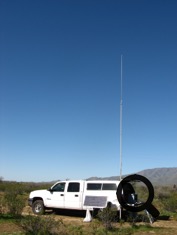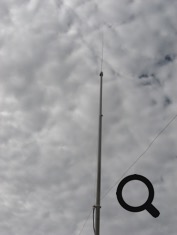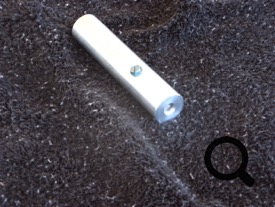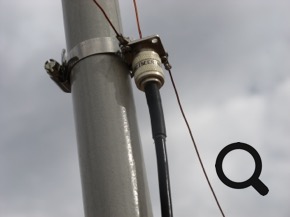Elevated Radial Wire Vertical Antenna
for
40m/20m
We have found this to be one of the most effective field antennas of all, especially on 40m (and even 20m). On the higher bands, a dipole will likely outperform, since on those bands it's easier to get those up to an effective height.
As most of us know, a dipole works really well if you can get it up at least 0.5 W/L high. But on 40m, that is 69-feet !! This antenna is the answer to that challenge. It was first described by W1IS in "Even More Wire Antenna Classics", Vol 3. You can read that article to learn about just how effective this antenna can be.
It can be built for any band 40m-10m, but it's most effective on 40m and 20m, due to the challenge of getting a dipole up to an effective height on those bands. You'll need a non-metallic mast to support the wire center-element, and then there are two 1/4 W/L wire radials, 180-degrees apart at the feedpoint (which gives an omni-directional radiation-pattern, with a low 20-degree takeoff-angle - great for DX).
Think of this antenna as an inverted "T", with the feedpoint at the junction. It's easy to make out of wire, and really easy to tune. The only part you need is an SO-239 4-hole flange connector!!
A nice thing about this antenna is that the feedline attaches only 10-feet up the mast, so you have a short coax run.
The radials should be at least 10-feet high to eliminate the ground losses. So for 20m, you'll need a 26-foot mast, and for 40m, a 43-foot mast. (Or you can hang it from a tall tree).
A really slick version of this antenna uses a 102" CB whip at the top to eliminate 8.5-feet of that mast requirement and the upper-part of the center-wire driven-element. So with that version, you only need an 18-foot mast for 20m, and a 34-foot mast for 40m. A length of wire attached to the bottom of the whip-mount makes up the remainder of the 1/4 W/L of the center element. The whip-mount rod slips partway down into the inside of the fiberglass mast.
If you want to go that route, you'll need to fabricate a whip-mount out of tubular aluminum rod, with a 3/8-24 threaded hole in one end for the whip, and a way to attach a wire to the mount. You can either use a screw-type hose clamp, or drill/tap a hole for a screw to attach the wire to. I use a 1" diameter aluminum rod, since the top section of my mast is 1.0" ID.
We use #18 wire (plenty big enough), and 26lb fishing line to string up the radials (and our other wire-antennas). Super-strong and super-cheap, just like we like it. A spool has 1885 feet for around $6 on Amazon. No bother coiling it up, just toss it when done. The radials can be horizontal, or a slight down-slope will actually improve the match a bit. Any end-support will work (trees, 6-foot piece of rebar in the ground, etc). And with the fishing line, no end-insulators needed !!
For 20m, I cut the center-element to 16.5 feet (total), and start out with the radials at 17-feet each. I trim the two radials equally for resonance. They don't have to be exactly the same length as the center element. On 40m, just double those numbers.
The takeoff (elevation) angle changes slightly as you elevate the (radial) height. At 10-feet, it's about 19-degrees. At 13-feet, it's about 17.5-degrees, and at 16-feet, it's 16-degrees (getting into real DX-territory there!!)
The best mast that we've found for field work is the awesome DX Engineering fiberglass tubing. VERY strong and rigid, and the telescoping pieces fit inside each other with precision. These are simply GREAT. And if you want to use them to support a dipole up high, 46-feet or more is no problem, without guy wires in moderate winds!! You just need a secure base at the bottom (see the Mast Mounting section on this site). Typical DXE p/n for the 1" I.D. section is DXE-FT1250-90SL.



